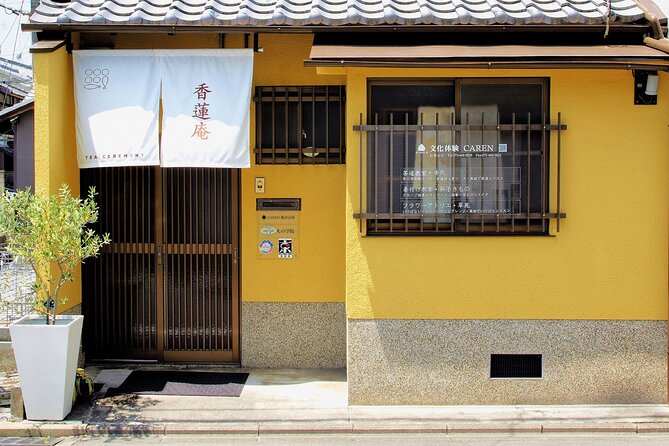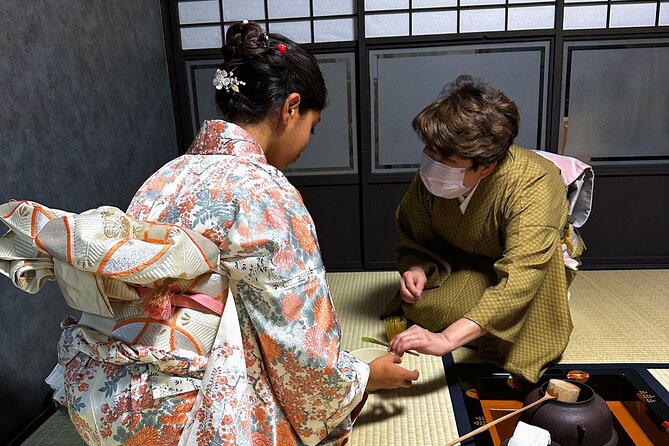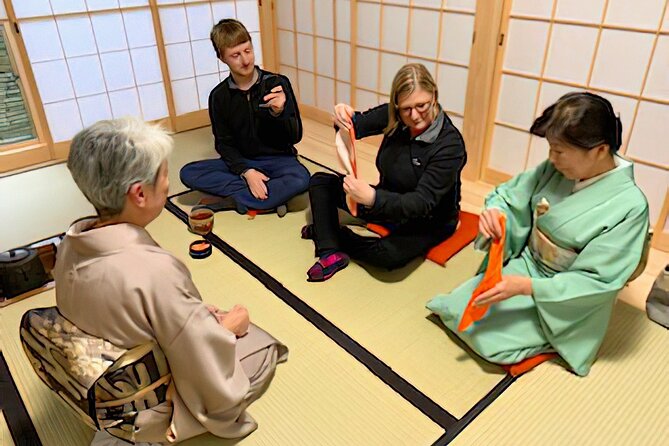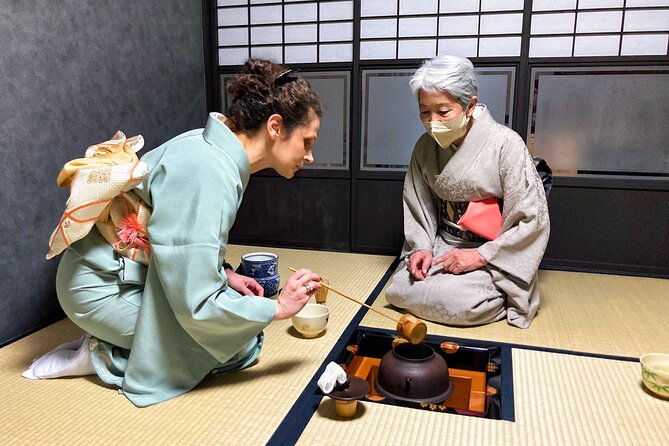Step into the serene world of Kyoto’s tea ceremony near Daitokuji, where the delicate art of brewing tea intertwines with the grace of wearing a traditional kimono. In this intimate gathering, guests witness the tea master’s skillful movements and might even get the chance to brew their own cup of tranquility. The blend of meticulous rituals and culture promises an unforgettable experience that unveils the essence of Japanese tradition in a way that words fall short of capturing.
Good To Know
- Authentic tea ceremony experience near Daitokuji temple in Kyoto.
- Opportunity to wear ceremonial kimono with traditional significance.
- Hands-on tea brewing session for immersive cultural engagement.
- Intimate setting with a maximum of 8 participants for personalized attention.
- Conveniently located near public transportation for easy access.
Here's some other great tours and experiences nearby we think you'll like.
Experience Details
Set out on a traditional Japanese tea ceremony in Kyoto, where you’ll don ceremonial kimono, witness a tea master’s expertise, and even try your hand at brewing tea. This immersive experience allows for a maximum of 8 travelers, ensuring an intimate setting.
Operated by CAREN, participants can explore the intricate world of tea ceremonies while surrounded by the beauty of Kyoto. From learning about kimono patterns to observing the meticulous preparation of tea by a seasoned professional, every moment is filled with cultural richness.
The opportunity to brew your own tea adds a hands-on element to this ancient tradition, making it a truly unforgettable experience for those seeking a deeper understanding of Japanese customs and rituals.
Logistics and Accessibility

Participants in the traditional Japanese tea ceremony in Kyoto can expect logistical details that enhance their overall experience, including information on accessibility and key points related to the activity.
Upon booking, participants receive a confirmation to ensure smooth arrangements. While the venue isn’t wheelchair accessible, it does accommodate strollers. Conveniently located near public transportation, the activity offers infant seats for added comfort. Participants can rest assured that the experience will conclude back at the meeting point.
These logistical considerations aim to make the tea ceremony accessible to a wide range of participants, ensuring a seamless and enjoyable experience for all. With these details in place, participants can focus on seeing the beauty and tradition of the Japanese tea ceremony.
Cancellation Policy and Weather Info

The CAREN-operated Kyoto Tea Ceremony With Kimono experience features a comprehensive cancellation policy and weather information to ensure participants are well-informed and prepared for any unforeseen circumstances. Participants can receive a full refund if they cancel up to 24 hours in advance, but no refund is available for cancellations made less than 24 hours before the start time. Changes are not accepted within 24 hours of the experience. Since the tea ceremony is weather-dependent, there is an option for a refund or rescheduling in case of unfavorable weather conditions.
| Cancellation Policy | Refund Policy | Changes Policy |
|---|---|---|
| Cancel up to 24 hours | Full refund | Changes not accepted less than 24 hours |
| Less than 24 hours | No refund | before start time |
This detailed policy ensures that participants are aware of the terms and conditions regarding cancellations and changes.
Traveler Feedback and Reviews

Travelers have consistently praised the Kyoto Tea Ceremony With Kimono experience, giving it an impressive overall rating of 5.0 based on 100 reviews from Viator travelers.
The feedback highlights the following:
-
Positive Staff Interaction: Visitors appreciate the knowledgeable and friendly staff who enhance the overall experience.
-
Beautiful Kimonos: The ceremonial kimonos provided are well-received for their authenticity and elegance.
-
Authentic Tea Ceremony: Participants value the opportunity to witness a professional tea master in action and try their hand at brewing tea.
-
Cultural Immersion: Guests enjoy the deep dive into Japanese culture, gaining historical insights and recommendations for a unique cultural experience.
Experience Highlights

Experiencing the Kyoto Tea Ceremony With Kimono immerses individuals in a world of cultural richness and historical tradition. Participants can look forward to an intimate master tea ceremony where they’ll explore the fascinating history of this ancient practice.
Dressing in formal kimono adds a touch of elegance, allowing individuals to choose their own kimono patterns and fully embrace the ceremonial atmosphere. After the tea ceremony, guests have the opportunity to mix their own tea, gaining hands-on experience and learning the intricate steps involved in the art of tea preparation.
Sharing this meditative experience with a small group enhances the sense of community and allows for a deeper appreciation of the incredible legacy behind this time-honored tradition. This activity is suitable for all ages, making it an ideal choice for those seeking cultural enrichment and unforgettable memories.
Dressing in Kimono

Participants in the Kyoto Tea Ceremony With Kimono experience the art of dressing in traditional garments that symbolize elegance and cultural heritage. The process of donning a kimono involves intricate steps that highlight the significance of each garment worn.
Here is a breakdown of the steps involved in dressing in a kimono:
-
Choosing the Kimono: Participants select from a variety of kimono patterns, each representing different meanings and occasions.
-
Layering the Garments: The layers of the kimono are carefully wrapped and tied in a specific manner, showcasing the wearer’s respect for tradition.
-
Adding the Obi Belt: The obi belt is intricately tied around the waist, symbolizing elegance and completing the ensemble.
-
Final Touches: Accessories such as fans, sandals, and hair ornaments are added to complement the kimono attire.
Tea Ceremony Preparation

In preparation for the tea ceremony experience, guests engage in traditional rituals to enjoy the art of Japanese tea culture. Participants are guided through the meticulous process of cleansing themselves physically and mentally, symbolizing a fresh start before entering the tea room. This cleansing ritual is an essential aspect of the ceremony, emphasizing the importance of mindfulness and respect for the tradition.
Following this, guests are invited to observe the intricate preparation of the tea by the master, learning about the precise movements and gestures involved. The atmosphere is serene and focused, creating a sense of anticipation and reverence for the upcoming ceremony.
Through these preparatory steps, participants begin to appreciate the depth and significance of the tea ceremony in Japanese culture.
Sharing Tea Ceremony Experience

As the tea ceremony unfolds, participants find themselves immersed in a tranquil ambiance, enveloped by the rich traditions and cultural significance of the experience. The act of sharing this serene moment with others enhances the overall impact of the ceremony, creating a sense of unity and camaraderie among attendees.
Here are four key aspects that contribute to the shared tea ceremony experience:
-
Bonding: Through the shared rituals and mindfulness of the ceremony, participants forge connections with each other, fostering a sense of community.
-
Learning Together: Observing and participating in the tea preparation process as a group allows for mutual learning and appreciation of the intricate details involved.
-
Cultural Exchange: Engaging in the tea ceremony collectively provides an opportunity for cultural exchange and understanding among diverse participants.
-
Memorable Moments: The shared experience of savoring the tea, donning traditional attire, and engaging in the ceremony together creates lasting memories and shared stories to cherish.
Frequently Asked Questions
Can Children Participate in the Tea Ceremony Wearing Kimonos?
Children can participate in the tea ceremony wearing kimonos. The experience offers culture and educational opportunities for all ages. They can enjoy the enchanting ritual of brewing tea and donning traditional attire in a memorable setting.
Are Photos Allowed During the Tea Ceremony?
Yes, participants are allowed to take photos during the tea ceremony experience. Capturing moments during the ceremonial activities, wearing kimono, and tea preparation is encouraged to cherish and share the culture and memories.
Is There a Restroom Available During the Experience?
Yes, there is a restroom available during the experience. Travelers can access the restroom for convenience. It ensures comfort and accessibility throughout the tea ceremony and kimono activity, allowing participants to fully enjoy the experience.
Can Participants Keep the Kimono After the Ceremony?
Participants cannot keep the kimono after the tea ceremony. The ceremonial attire is typically provided for the duration of the experience. This ensures an authentic and immersive cultural encounter while adhering to traditional practices and guidelines.
Is There a Recommended Dress Code for Under the Kimono?
For proper attire under the kimono, comfortable clothing is recommended. Opt for lightweight, breathable layers as the kimono can be warm. Suggesting simple, modest attire allows participants to fully enjoy the tea ceremony experience in comfort.
The Sum Up
Enjoy the serene world of Japanese tea ceremonies near Daitokuji in Kyoto. Dress in a traditional kimono, witness the art of tea brewing up close, and even try your hand at preparing a perfect cup of tea.
This intimate and authentic experience allows you to appreciate the meticulous rituals involved in this ancient tradition. Create lasting memories and explore Japanese culture with this unique cultural encounter.
